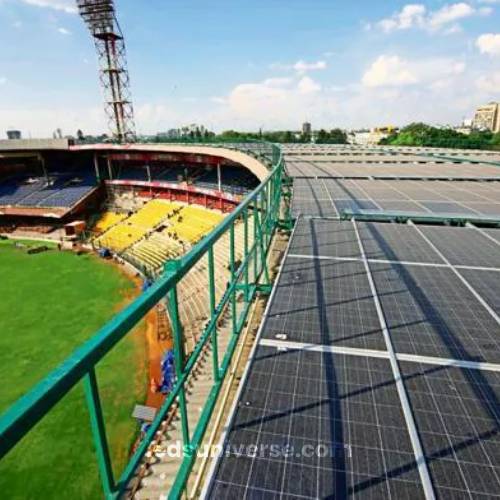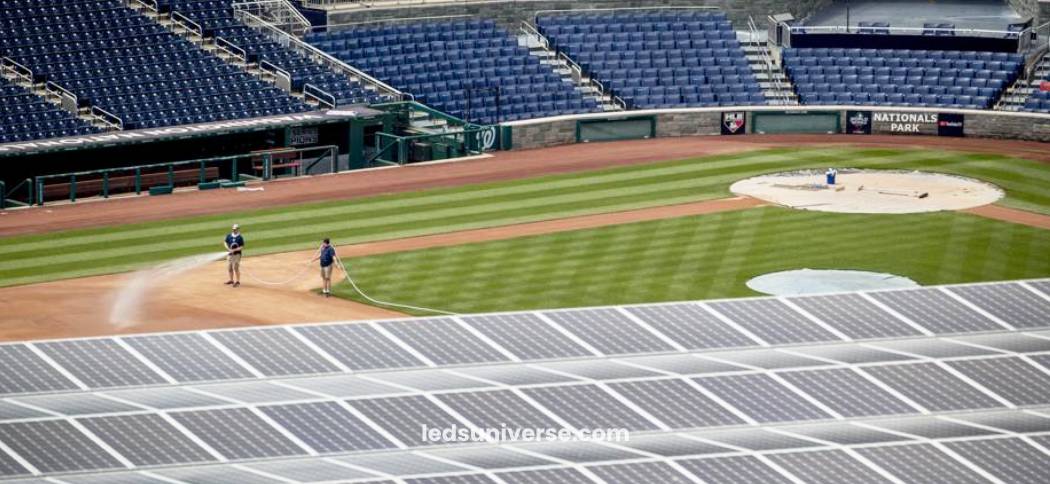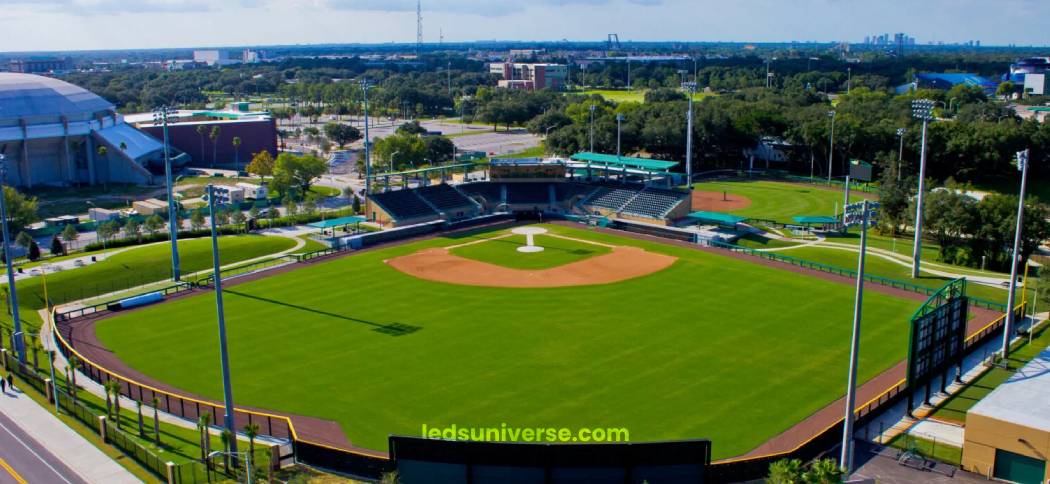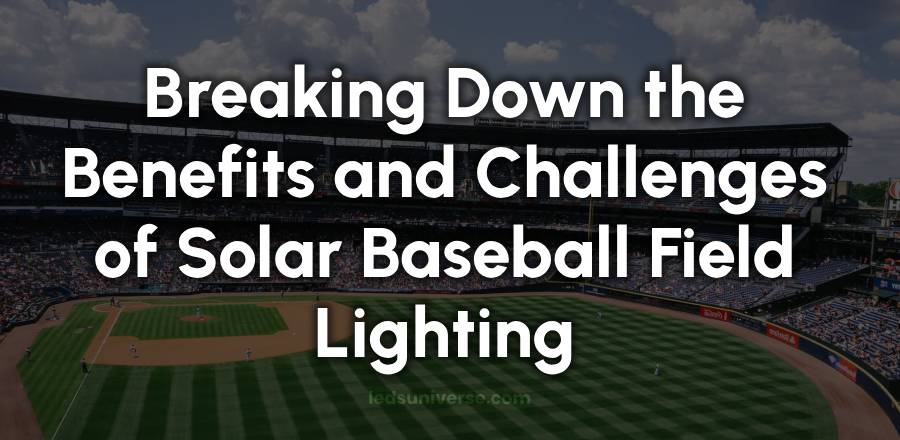As energy efficiency becomes a larger priority in facility design and maintenance, solar lighting is being adopted in a variety of settings, including sports fields. Baseball fields, which traditionally rely on powerful electric lighting for evening games and practice, are now being evaluated for solar-powered solutions. These lighting systems rely on solar panels to capture sunlight and store energy, which is then used to power field lights. The shift from traditional grid-based power to solar energy introduces new dynamics in terms of performance, costs, reliability, and overall field experience.
Table of Contents
ToggleUnderstanding How Solar Lighting Works
 Across the country, interest in solar lighting for baseball fields is growing steadily as facility operators, local governments, and private developers seek cost-effective and energy-conscious alternatives to traditional lighting systems. Municipal parks departments, school districts, youth athletic organizations, and even university-level sports programs are among the early adopters testing the viability of solar technology in field settings. These groups are often motivated not only by potential cost savings, but also by a broader push toward cleaner energy solutions and more sustainable infrastructure.
Across the country, interest in solar lighting for baseball fields is growing steadily as facility operators, local governments, and private developers seek cost-effective and energy-conscious alternatives to traditional lighting systems. Municipal parks departments, school districts, youth athletic organizations, and even university-level sports programs are among the early adopters testing the viability of solar technology in field settings. These groups are often motivated not only by potential cost savings, but also by a broader push toward cleaner energy solutions and more sustainable infrastructure.
In some cases, facilities have opted to completely replace their existing lighting systems with solar-powered alternatives. This typically occurs in regions that receive high levels of sunlight year-round and where financial incentives such as grants or tax credits help offset installation costs. In other scenarios, particularly in areas with less consistent sun exposure, hybrid systems are being implemented. These setups combine solar panels and batteries with backup grid connections, allowing the lights to draw power from the sun during optimal conditions while falling back on the grid when additional energy is needed. This approach ensures continuous performance without sacrificing reliability and helps facilities gradually transition toward more renewable energy use.
While adoption is still in progress and not yet standard nationwide, the trend is clearly moving toward broader acceptance. As technology continues to evolve and costs gradually decrease, solar lighting is likely to play a larger role in shaping the future of sports facility planning. The adaptability of these systems and their capacity to serve a variety of field types and geographic regions suggest that their presence will expand well beyond early test sites and pilot programs in the coming years.
Advantages of Solar Baseball Field Lighting
Energy Cost Reduction

One of the standout benefits of installing solar lighting systems on baseball fields is the considerable reduction in electricity expenses. Traditional field lighting can be expensive to operate, especially when used regularly during evening games or practice sessions. Solar lighting systems rely on sunlight to generate energy, meaning they don’t consume electricity from the utility grid. As a result, operators avoid recurring utility charges. Over months and years, the cumulative savings can be substantial, eventually covering the initial cost of installation and contributing to a lower overall cost of ownership. This financial aspect makes solar systems an appealing choice for schools, municipalities, and recreational leagues that often operate with limited or carefully allocated budgets. Additionally, the predictability of solar energy costs, in contrast to fluctuating utility rates, can provide more stable long-term financial planning.
Low Environmental Impact
Solar lighting systems offer a cleaner alternative to conventional lighting by harnessing renewable energy from the sun. Unlike fossil-fuel-based electricity, solar power does not emit pollutants or produce harmful byproducts during energy generation. This allows baseball field operations to reduce their contribution to air and carbon pollution. When multiple facilities adopt solar technologies, the cumulative effect can help ease the strain on local power grids and reduce demand for energy generated from nonrenewable sources. Beyond air quality, solar installations also create less environmental disruption since they often require fewer underground cables and utility infrastructure. By transitioning to solar lighting, facilities demonstrate environmental responsibility and alignment with broader sustainability initiatives that benefit the community and future generations.
Minimal Ongoing Maintenance
After installation, solar lighting systems generally require less hands-on maintenance compared to traditional lighting setups. LED lights, which are commonly paired with solar systems, have lifespans that greatly exceed those of conventional bulbs—often lasting up to 50,000 hours or more before needing replacement. Additionally, because the systems are designed to function independently, they often feature sealed batteries and weather-resistant housings that protect components from the elements. This reduces the need for frequent inspections, wire checks, or electrical troubleshooting. Facilities that switch to solar lighting often find themselves spending less time and money on repairs and upkeep, which is especially beneficial when maintenance teams are small or when access to elevated lighting fixtures is limited or costly.
Independence from the Power Grid
Solar lighting systems operate independently from local power grids, which offers clear benefits in both urban and rural settings. For baseball fields in remote areas where access to electrical infrastructure is limited or unavailable, solar power enables lighting installations without the need for extensive trenching or utility hookups. Even in areas with established electrical service, the independence of solar systems means they continue to function during power outages caused by storms, accidents, or infrastructure failures. This resilience allows fields to remain operational when needed most, ensuring that games, practices, or community events can continue without interruption. The self-sufficiency of solar lighting also enhances a field’s reliability, making it a dependable space regardless of external energy conditions.
Flexible Installation Options
Unlike traditional lighting systems that are often constrained by the need for utility access, solar lighting systems offer a much higher degree of placement flexibility. Because they don’t need to be wired into a central power source, lighting units can be installed based on ideal lighting geometry rather than electrical convenience. This flexibility is especially valuable for baseball fields located in parks, open land, or areas with uneven terrain. Solar lights can be placed exactly where they’re needed most, optimizing the layout for field coverage, brightness, and safety. In some cases, the ease of installation can also speed up project timelines, since trenching, conduit laying, and coordination with utility providers are either minimized or eliminated entirely. For new fields, this can reduce site preparation complexity and create opportunities for creative field design.
Challenges of Solar Baseball Field Lighting

High Upfront Costs
One of the main barriers to adopting solar lighting on baseball fields is the initial investment. High-quality photovoltaic panels, battery systems, LED fixtures, and mounting equipment come at a premium compared to traditional lighting materials. In addition to hardware costs, installation requires specialized labor and potentially a site assessment to determine optimal system specifications. These expenses are often concentrated at the beginning of the project, which can be difficult for smaller organizations or public facilities working with fixed or donor-based funding. While there are long-term savings, the upfront financial commitment may delay project approval or require phased implementation. It is also worth noting that cost comparisons should consider not just the lighting equipment, but the potential avoidance of grid extension fees, permitting, and trenching that would otherwise be required for conventional lighting.
Variable Performance Based on Weather
Solar energy is naturally dependent on weather conditions, and this reliance can affect how consistently a lighting system performs. In regions where sunshine is frequent, solar panels are able to generate more than enough power to charge the system’s batteries. However, in areas with prolonged cloudy weather, heavy rainfall, or seasonal darkness, energy collection becomes less predictable. Even though many systems are designed with battery reserves that can store multiple days’ worth of energy, extended periods of poor sunlight can still reduce system performance. Facilities located in such climates may require oversized systems, additional battery banks, or supplementary power sources to ensure uninterrupted operation. These adaptations can further increase the cost and complexity of the installation.
Lighting Intensity and Coverage Limitations
Baseball fields require high levels of consistent illumination, particularly for competitive play during evening hours. Traditional stadium lights are known for their strong brightness and even coverage. Solar-powered lights, while increasingly capable, still face challenges in matching that intensity, especially when energy storage is limited or when design compromises are made to reduce costs. Achieving the correct balance between light distribution and battery efficiency requires careful system design and advanced photometric planning. Fields that host tournaments, televised games, or large crowds may find solar lighting less suitable unless the system is specifically engineered to meet those higher demands. Even with modern LEDs, ensuring that shadows are minimized and player visibility is maintained can be more difficult without access to unlimited grid power.
Battery Lifecycle and Replacement Costs
The performance of solar lighting systems depends heavily on the quality and condition of their batteries. Over time, battery performance degrades, reducing storage capacity and reliability. Typically, batteries need to be replaced every five to ten years depending on use, temperature conditions, and manufacturer specifications. These replacements add to the long-term cost of the system and must be planned for in operational budgets. Additionally, disposal of old batteries must be done responsibly, as many contain chemicals that require special handling. Cold weather can also affect battery efficiency, and systems exposed to wide temperature fluctuations may require insulated or climate-resistant enclosures. Ensuring that batteries remain operational and effective over time is vital for maintaining lighting consistency and field usability.
Design and Planning Complexity
Solar lighting systems are not one-size-fits-all solutions. Designing an effective system requires a thorough understanding of the field’s energy needs, usage patterns, sun exposure, and weather conditions. Site-specific considerations such as tree cover, building shadows, and slope orientation can all affect solar panel performance. Accurate calculations must be made regarding power generation, battery storage, and lighting output to ensure the system functions as intended. Mistakes in the planning phase can lead to underperformance, shortened battery life, or insufficient lighting during games. For this reason, facilities often need to work with consultants or solar engineers to develop customized solutions. The planning and permitting phase may take longer than that of a conventional installation, requiring coordination with local authorities and compliance with relevant energy codes.
Comparing Solar and Traditional Lighting Systems
When evaluating solar versus traditional lighting, both systems have strengths that align with different field needs. Conventional lighting offers higher brightness and consistent performance, but comes with ongoing energy costs and often higher maintenance demands. Solar lighting offers independence and energy savings but may not deliver the same lighting quality in every scenario. Decision-makers must weigh factors such as location, budget, environmental goals, and long-term maintenance capabilities to determine the most suitable option.
Adoption Trends and Real-World Use Cases
Across the country, interest in solar lighting for baseball fields is growing steadily as facility operators, local governments, and private developers seek cost-effective and energy-conscious alternatives to traditional lighting systems. Municipal parks departments, school districts, youth athletic organizations, and even university-level sports programs are among the early adopters testing the viability of solar technology in field settings. These groups are often motivated not only by potential cost savings, but also by a broader push toward cleaner energy solutions and more sustainable infrastructure.
Transitioning to Solar-Powered Lighting Systems
In some cases, facilities have opted to completely replace their existing lighting systems with solar-powered alternatives. This typically occurs in regions that receive high levels of sunlight year-round and where financial incentives such as grants or tax credits help offset installation costs. In other scenarios, particularly in areas with less consistent sun exposure, hybrid systems are being implemented. These setups combine solar panels and batteries with backup grid connections, allowing the lights to draw power from the sun during optimal conditions while falling back on the grid when additional energy is needed. This approach ensures continuous performance without sacrificing reliability and helps facilities gradually transition toward more renewable energy use.
Successful Installations in Solar-Friendly Regions
A number of successful installations have been documented in states like Arizona, California, Texas, and Florida, where climate conditions favor solar energy production. Sports complexes in these regions have reported reductions in energy bills, greater autonomy from the electrical grid, and improved satisfaction among stakeholders due to quieter operations and reduced visual clutter from utility infrastructure. In addition to full-scale fields, smaller practice areas, batting cages, and auxiliary spaces such as parking lots or walkways are also being illuminated with solar lighting to extend the hours of usability and improve safety after dark.
Case Study: School District in Southern California
One notable example includes a school district in Southern California that installed solar lighting at multiple fields to extend the usability of its facilities into the evening hours without incurring high operational costs. The project included angled solar panel arrays mounted directly on light poles, allowing for both efficient power generation and streamlined use of space. After a full season of use, district administrators reported lower-than-expected maintenance costs and increased scheduling flexibility for practices and recreational use. Feedback from coaches and players emphasized that visibility was consistent with traditional systems, thanks in part to thoughtful placement and modern LED technology.
Case Study: Revitalizing a Public Park in the Midwest
Another case involved a public park in the Midwest that chose solar lighting as a way to revive an aging baseball field without undergoing expensive trenching and electrical rewiring. The park was previously limited to daytime use due to poor lighting, but after installing solar-powered poles with battery storage, community members were able to hold evening games and host local tournaments. This change revitalized interest in the park, increased recreational use, and reduced the scheduling pressure caused by shared daytime access.
Enhancing the Experience Beyond the Field
Beyond the field itself, solar lighting is also being used to improve the overall experience at sports venues. Walkways, bleacher areas, restrooms, and concessions zones are now being lit using independent solar units that operate on timers or motion sensors. These additions help reduce liability by improving nighttime visibility, while also contributing to a more comfortable and accessible environment for attendees. In many cases, the use of solar lighting in these secondary zones serves as a trial run before larger-scale field lighting installations are considered.
Insights and Knowledge Sharing Among Facility Managers
As word spreads about the viability of these systems, more facility managers are exploring solar options during renovations or new construction planning phases. Lessons learned from early adopters have helped guide system designs, panel orientations, battery choices, and fixture selections. Practical tips such as avoiding shaded areas, regularly cleaning panel surfaces, and planning for battery replacement cycles have been shared among peer networks and municipal associations. These insights are helping to create a growing knowledge base that encourages further experimentation and wider adoption of solar solutions in recreational sports.
Conclusion
Solar lighting for baseball fields presents a compelling alternative to traditional systems, particularly for those looking to reduce energy use and explore modern technologies. The potential for cost savings, reduced maintenance, and increased reliability in areas without strong electrical infrastructure makes solar lighting an attractive choice in many scenarios. At the same time, challenges such as high upfront investment, design requirements, and climate dependence remain considerations that must be factored into any decision. A well-designed solar lighting system can offer years of effective service when matched appropriately to the field’s needs and local conditions. As innovation continues, the role of solar solutions in athletic lighting will likely grow, offering more flexible and cleaner options for the future of sports facility design.
